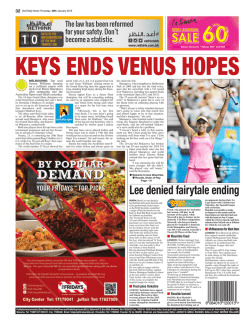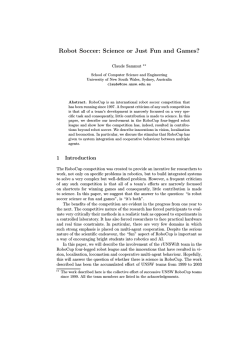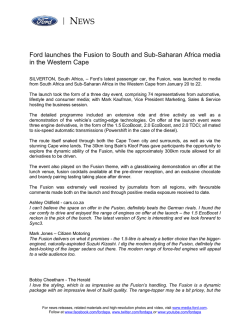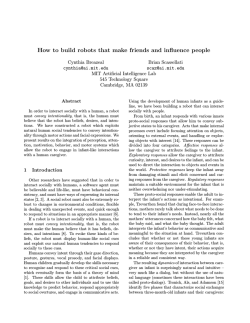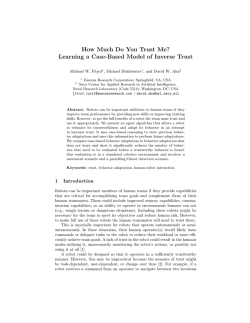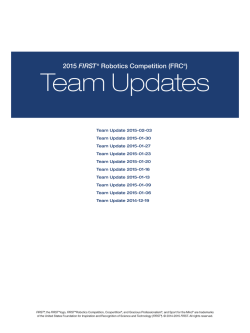
Sensor Fusion based on Multi-Self-Organizing
Sensor Fusion based on Multi-Self-Organizing Maps for SLAM Gabriel Leivas, Silvia Botelho, Paulo Drews, Mônica Figueiredo and Celina Häffele Abstract— This paper proposes the use of topological maps in order to provide a method of SLAM feature, based on sensor fusion, that treats better the problem of inaccuracy of the current systems. The contribution of the work is in the algorithm that uses multiple sensory sources, multiple topological maps, to improve the estimation of localization, in order to be as generic as possible, so the same is valid for both internal and external environments (structured or not). When this is made with sensors of clashing characteristics we can obtain better results, because something not perceived by a sensor might be perceived by others, so we can also reduce the effects of error measurement and obtaining a method that works with the uncertainties of the sensors. A simulator was developed to validate the proposed system, through a series of tests with a set of real data. The results show the robustness of the system in relation to the sensorial imprecision and to the gain in predicting the robot’s location, resulting in a more appropriate treatment to the errors associated with each sensor. I. INTRODUCTION Autonomous navigation is one of main tasks executed by autonomous vehicles. Navigation can be defined like a set of procedures needed to a system, reach into a final configuration through a initial position, planning paths, avoiding obstacles and into a certain time to accomplish the task. The navigation process can be divided in five levels: • Environment Mapping; • Robot Localization; • Path Planning; • Path adaptation to time restrictions; • Trajectory execution. The two first stages, mapping and localization, when made simultaneously, create a problem called SLAM (Simultaneous Localization and Mapping) [9][10]. A. SLAM Thrun [8] defines a SLAM problem as a situation when the robot does not have access to map of the environment and unknowns his pose. In SLAM, the robot builds an environment map and simultaneously localizes itself. The problem of SLAM is currently one of the most challenging problems in robotics. a) SLAM Problems: • Online SLAM: Appears from the need of estimate future robot pose through its current value, considering only the variables analyzed at present time. • Complete SLAM: Seeks estimate of future robot pose through a whole map, instead of only the current position on the map. In particular, the online SLAM is the result of integration of past poses of the complete SLAM, as shown in the Equation 1: p(xt , m|z1:t , u1:t ) = Z Z Z ... p(x1:t , m|z1:t , u1:t )dx1 dx2 ...dxt−1 (1) b) Challenges of SLAM: The first aspect that worsens the complexity of the mapping problem comes from the high dimensionality of the entities to be mapped. The second and possibly the most difficult problem in robotic mapping is the problem of correspondence or matching. This problem consists in determine if two distinct sensor measurements taken at different points in time correspond to the same physical object in the world. The environment dynamics is the third problem, it adds other possible interpretations of the data collected. The fourth and final challenge is the fact that robots must choose their path during mapping. The joint solution (map and localization) has a important impact on robotics applications referring to the to the robot’s autonomous capability. Considering this, the mapping problems are now discussed together with the location in SLAM problems. c) Mapping: Metric Mapping: Within the current metric representation of the environment, the map can be constructed by a grid of occupation or a map of features. • • Grid of Occupation: This approach consists of using a range sensor, that returns the relative distance to an obstacle within a closed environment. Each collected measure brings an associated information related to the existence or not of obstacles in a certain region of the environment. These information are then projected onto a horizontal map taking in consideration the knowledge of the robot’s pose. Thus, each area of the real environment would correspond to an area of the map. The map, in turn, is summarized to a matrix whose cells store the probability of the region is empty or occupied [5]. Map of Features: Another family of mapping algorithms approaches the problem of building maps composed of basic geometric shapes or objects such as lines, walls etc [9]. Topological Mapping: It consists of simple memorization of the sensorial information while the robot navigates through the environment, so that it is possible to identify situations where the robot has already been, simply comparing the current sensorial information with those already recorded [8]. • Growing Cell Structures: Proposed by [6] to solve the main problem of the Kohonen networks [3], its fixed topology, once you know the optimal size of the network is not always possible [6]. Without that information the capacity of the net can be limited. That type of SOM with variable topology allows the network to grow starting from a minimum n-dimensional initial topology. Another characteristic of the method is the degrees of trust of the sensors, which are directly related to the estimated robot’s location, for example sensors more reliable overcome when compared with sensors of low trust level. The spaces (maps) responsible for storing the information of the sensors and of the fusion are: • • Sensorial Space. Localization Space. B. Sensorial Fusion Method used to integrate data from different sensors in a robot. The question of how best to integrate data from multiple sensors is particularly interesting when they may have different perceptions of the captured environment, increasing the characterization of the environment. Currently the two most used techniques for solving the problem are: Kalman Filter [2] and Particle Filter [8]. The difficulty with this approach is to establish a representation that allows a uniform response by different sensors. According to [4] we can extract two problems of sensorial fusion: • • Problem of stagnation: when to merge two not null sensorial responses, we find a null result. Problem of the infinite cycles: result of the robot’s limitations in obtaining the appropriate information of the environment and respond quickly to its changes. II. P ROPOSED M ETHOD The proposed approach aims at creating a method for simultaneous localization and mapping with the use of sensorial fusion and growing cell structures, for this, each sensor has its own map (sensory space) and is created through an integrating function, a general map called localization space, is shown in Figure 1. A. Sensorial Space Sensorial space is defined as a graph whose nodes represent, along the time, the sensorial perceptions through descriptors of dimension "m", where only with the use of its information (without position values), the identification is possible. Construction of Maps: The maps of the proposed approach are constructed through growing cell structures [6][7], with a triangular topology, since we face the problem of a 2D way. Each cell of that map has a neighborhood given by the connections of the own cell. In submitting an entry is chosen the winner neuron (BMU), and he and his neighborhood are adjusted. If the Euclidean distance between the BMU and the input is larger than a limit set by the user, a cell is created, Figure 2, being connected to BMU and his closest neighbor, thus ensuring the triangular topology of the network. Fig. 2. Illustration of a cell insertion: A new cell and its connections is inserted at each step, the inserted cell is in gray and the winner cell in red. In the proposed approach there is a limitation in the size of the map. In other words, at certain point, cells will be excluded and if the cells of their neighborhood, after the removal, are left with only one connection, they will also be removed. Therefore, the fundamental triangular topology won’t be maintained, as shown in Figure 3. A more detailed algorithm of Growing Cell Structures can be found in [1]. Fig. 3. Illustration of a cell removal: The cell A is removed. Cells B and C are in the neighborhood of A and are left behind with only one connection, for the removal of the five connections of A, then B and C should also be removed. Fig. 1. System Example. B. Localization Space Graph whose nodes represent the robot’s position already fused. This space is characterized by its interconnection with all the nodes of the sensorial maps that have impressions captured in the same analyzed time, as shown in Figure 4. where this is made to find out the displacement of all maps. c) Then the points are moved according to their degrees of trust (adjust the sensorial space): Px (t + 1) = Px (t) + 4x(1 − z); Py (t + 1) = Py (t) + 4y(1 − z); 3) After the displacement of all the presented points (in their respective maps of the sensorial space), already corrected, we start again the training in sensorial space, in which only the neighborhood of these points is updated. D. Flowchart of the System Fig. 4. Connections of the Localization Space. C. Integration Function The main purpose of the integration function is to correct the robot’s position in the localization space, although it also adjusts the local maps of the sensors. We can describe it in the following steps: 1) The different sensorial perceptions (values captured by the sensor in the same instant) are presented to their local maps (training of the sensor space), for example in sensors of vision, a set of descriptors captured in one frame. 2) After these informations are obtained, a series of metrics are applied to calibrate (correct) these values. This phase is called global training in the localization space: a) First we calculate the central location to all maps according to the central position of the other sensors, associated with their trust. After this we find the resulting central position (adjust of the robot’s location): P Zi ∗Xic XcR = P Zi ; YcR = P Zi ∗Yic P Zi ; where xic and yic is the central position of each sensor impression and zi are their degree of pertinence. b) After having that resulting central position, the displacement of the points is calculated: 4x = Xc R − Xi c; 4y = Yc R − Yi c; The Figure 5 illustrates the general operation of the system. 1) Acquisition of sensorial data (the robot’s position + descriptors). 2) Separate momentarily the descriptors and presents them to the local map (sensorial space). 3) The local map is updated (GCS). 4) Their data (the robot’s position + descriptors + trust of the sensor) are sent to the global map (localization space). 5) The adjustment of the robot’s position occurs, but also happens a feedback for the local maps of the sensorial space to be adjusted. 6) In the sensor space, the neighborhood of the points already presented is updated. Fig. 5. Flowchart of the Proposed Method. III. T ESTS AND R ESULTS Due to the need of validation of the proposed system, we looked for databases used as test pattern for SLAM. Among the surveyed, we found a database provided by the University of Malaga [11]. The available data counts with cameras, lasers and a GPS (used as reference). Among the various data sets available in the chosen repository to test the proposed approach, the choice was the Malaga6LParking, the Figure 6 shows the path traveled by the vehicle, in which the path in green represents the values captured by the sensors and in red the passage where there was no sensorial capture. Fig. 7. Fig. 6. Accumulated sensors error without the proposed approach Vehicle trajectory. A. Rate of compression of the system The experimental results began with compression rate. The Table I shows the number of readings presented to each sensor and the number of final nodes after all values been presented. This compression has a direct influence in the performance of the system, since the navigated environments can be represent with a few nodes, but in order to maintain the robustness of the system, we have the performance gain by not having to manipulate a large volume of data. Another feature shown is the capacity of the map described with the laser to represent the same environment as the visual sensor but with fewer nodes. TABLE I N UMBER OF NODES IN EACH MAP AND RATE OF DATA COMPRESSION . Sensor Laser Camera Presented data 7399 3028 Number of nodes 195 201 Rate of compression 97.365% 93.362% Fig. 8. Accumulated sensors error with the proposed approach. TABLE II G AINS OF THE METHOD IN RELATION TO SIMPLE MAPS Sensor Laser Camera Error without fusion 500 650 Error with fusion 340 550 Gain 32% 15.38% B. Accumulated System Errors 1) Accumulated sensors error with the approach without fusion: The Figure 7 illustrates the accumulated error of each sensor with their separate maps, in other words, the use of common growing cell structures. The error shown in red is related to the camera and in blue is related to the laser. Thus, the laser sensor is considered more reliable than the camera, receiving a greater trust degree. 2) Accumulated sensors error with the proposed approach: The Figure 8 illustrates the accumulated error of each sensor after the use of sensor fusion proposal. It may be noted that the accumulated error behaves as a linear function and the method only helps alleviate the slope of these straight lines, in that way, with the use of the method it is possible to reduce the speed at which this error is added to the robot, thus generating a substantial gain of location for it. The Table II illustrates the gain of each sensor with the proposed method. C. Results of the Simulator As presented in section 3, the data set used was the Malaga 6L. So the interface with this data can be seen in Figure 9 and 10. The interface was developed with OpenGL and the main features are rotation and translation at three axis. The interface allows a complete navigation of maps built. D. Performance issues System performance was shown satisfactory and clearly proved the quadratic characteristic of the proposed approach. Figure 11 demonstrates the accumulated processing time of the system for the test data, this curve clearly describes a quadratic function, thus confirming that the proposed algorithm just multiplies constant factors by the complexity of the based algorithm, not altering its order. Fig. 9. Simulator with two sensors the processing power embedded in robots may be limited. Another important characteristic of the proposed method is its robustness to sensorial inaccuracies, since the method by fusion of the captured sensors, makes it in a way that sensors with a higher degree of uncertainty has attenuated importance and more precise sensors become more prevalent. The results obtained in the tests were satisfactory, validating the proposal. We also notice the gain of accuracy in the maps of sensory space with values that demonstrate the effectiveness of the set of tests. Another striking feature of the tests was the level of data compression, over ninety percent, achieved by the proposed method. R EFERENCES Fig. 10. Simulator with two sensors in different perspective. Fig. 11. Complexity curve of the system in tests. IV. C ONCLUSIONS The proposed work presented a new method for Simultaneous Localization and Mapping (SLAM) with the use of GCS for sensorial fusion, in order to gain precision in position estimation of autonomous robots. The topological mapping based on Growing Cell Structures (GCS), although not widespread, is characterized by low computational cost and a simplified manner of construction. Therefore, the same one has its use indicated in real robots, because [1] Hodge, J. V., Austin, J.: Hierarchical Growing Cell Structures: TreeGCS. IEEE Transactions on knowledge and data engineering. 207– 218 (2001) [2] Kalman, R. E: A new approach to linear filtering and predictive problems. Transactions ASME, Journal of basic engineering,(1960) [3] Kohonen, T.: Self-organized formation of topologically correct feature maps. Biological Cybernetics, 59–69 (1982) [4] Anderson, T. L., Donath, M.: Animal Behavior as a Paradigm for Developing Robot Autonomy. Robotics and Autonomous Systems, 145– 168, (1990) [5] Elfes, A.: Using Occupancy Grids for Mobile Robot Perception and Navigation. IEEE Computer Society Press, volume 22, number 6 ,46– 57 (1989) [6] Fritzke, B.: Growing cell structures - a self-organizing network for unsupervised and supervised learning. Technical report-University of California, (1993) [7] Fritzke, B.: A growing neural gas network learns topologies.. Advances in Neural Information Processing Systems 7, 625–632, (1995) [8] Thrun, S. W., Burgard Fox, D.: Probabilistic Robotics. MIT Press, (2005) [9] Chatila, C., Laumond J. P.: Position referencing and consistent world modeling for mobile robots. IEEE International Conference on Robotics and Automation, 138–143, (1985) [10] H. F. Durrant-whyte, J. J. Leonard: Mobile robot localization by tracking geometric beacons. IEEE Transactions on Robotics and Automation, 376–382, (1991) [11] Blanco, J.L., Moreno, F.A, Gonzalez, J.: A Collection of Outdoor Robotic Datasets with centimeter-accuracy Ground Truth. Autonomous Robots, (2009) [12] Xiaochuan Zhao, Qingsheng Luo, Baoling Han : Survey on Robot Multi-sensor Information fusion Technology. World Congress on Intelligent Control and Automation, (2008) [13] Zhou Hong-bin: Multi-sensor Information Fusion Method Based on the Neural Network Algorithm. International Conference on Natural Computation, (2009) [14] Chauhan, S., Patil, C., Halder, A., Sinha, M.: FLIER: A Novel Sensor Fusion Algorithm. Industrial and Information Systems, (2008) [15] Garhwal, R. , Halder, A., and Sinha, M.: An Adaptive Fuzzy State Noise Driven Extended Kalman Filter for Real Time Orbit Determination. 58th International Astronautical Congress, (2007)
© Copyright 2025
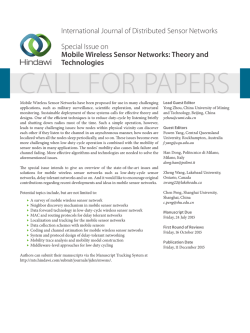
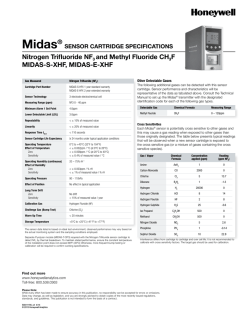
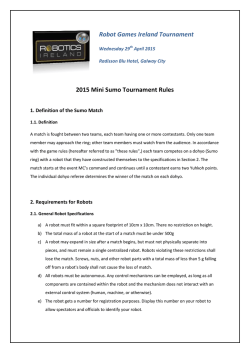
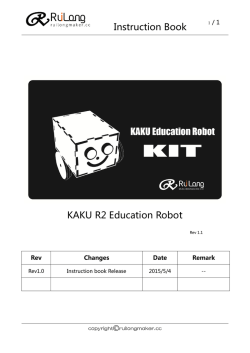
![[PDF] NS Series Network Sensors Catalog Page](http://s2.esdocs.com/store/data/000484399_1-7638be45b4871a11b0b359cb4bdd6b58-250x500.png)
